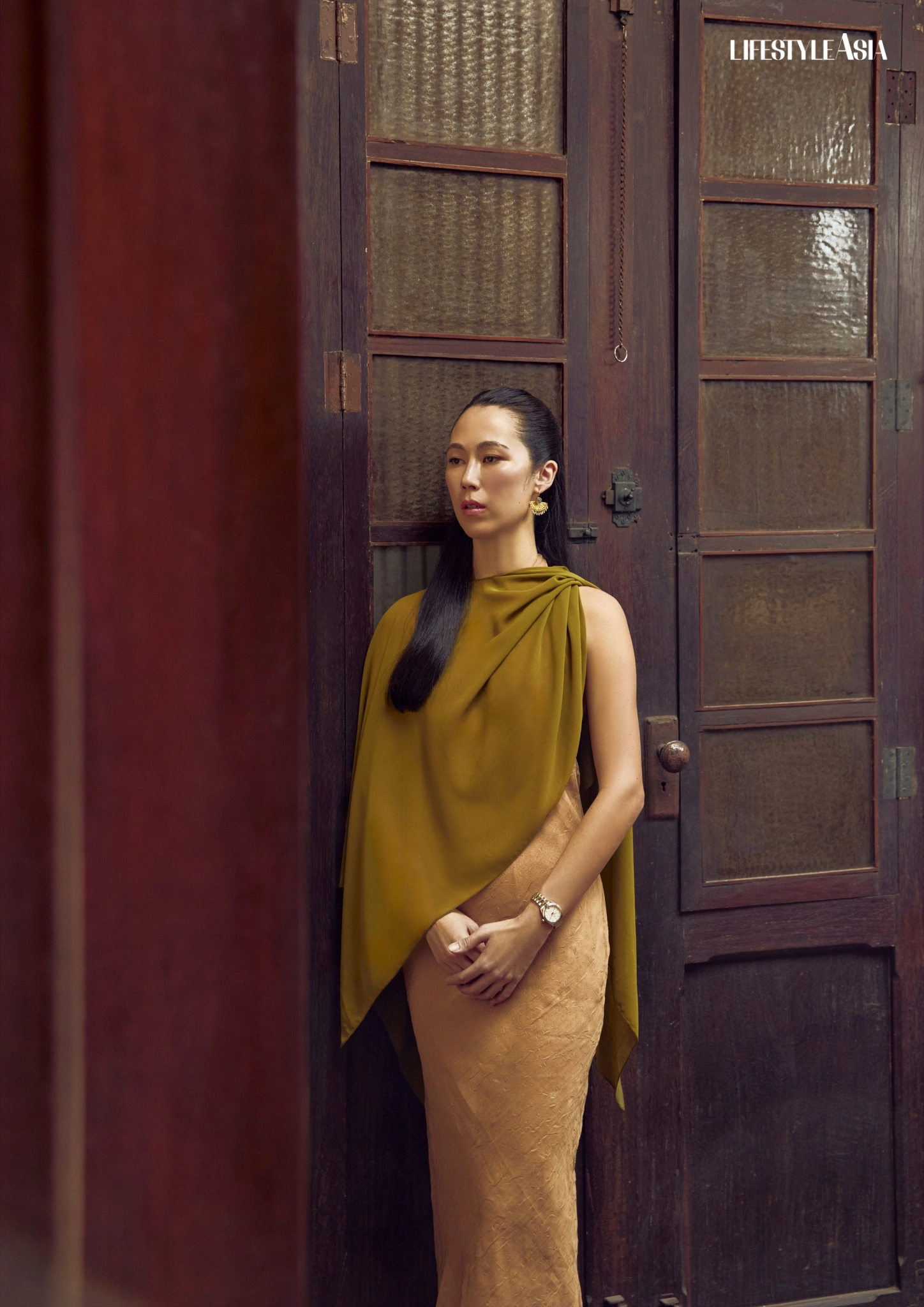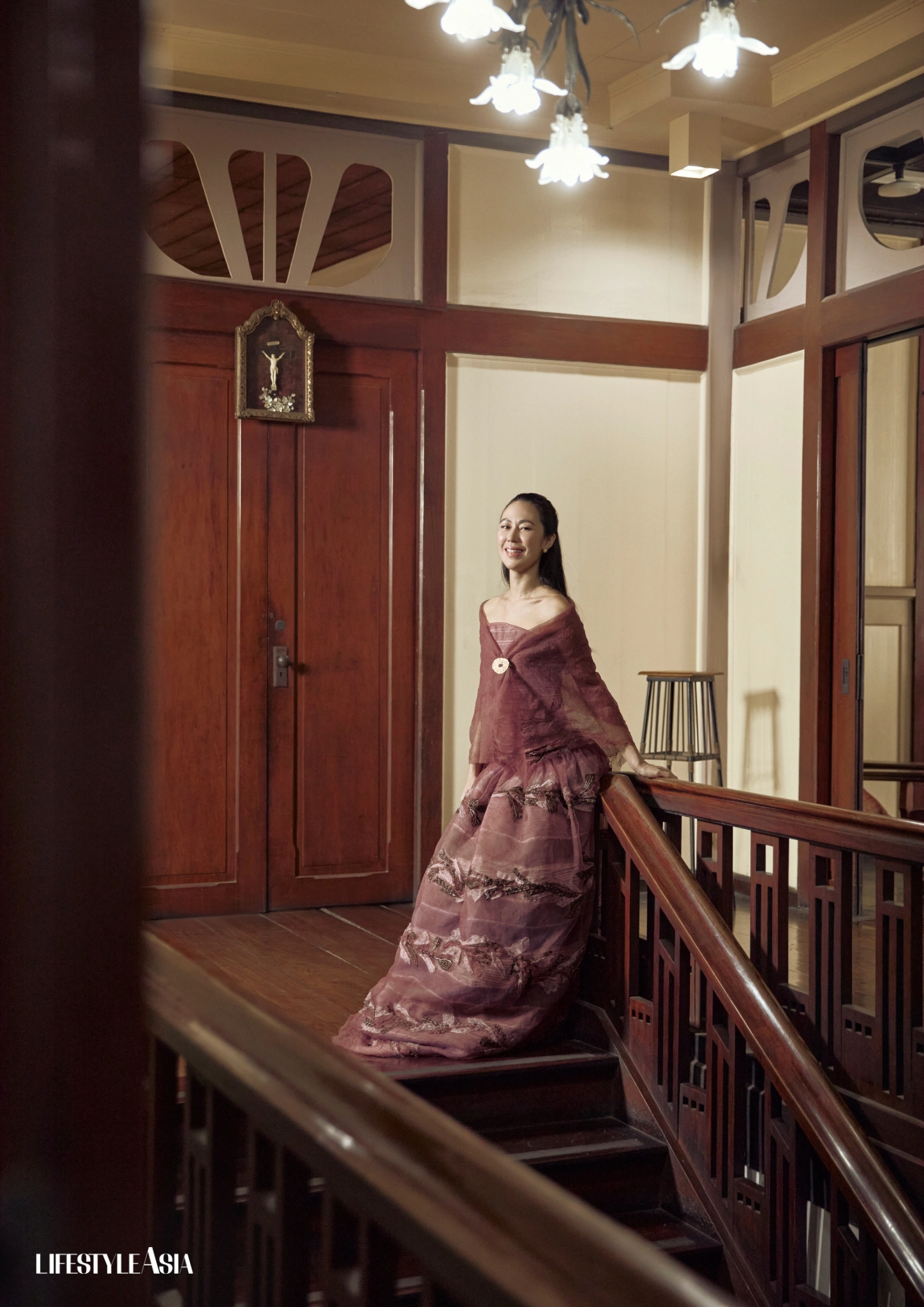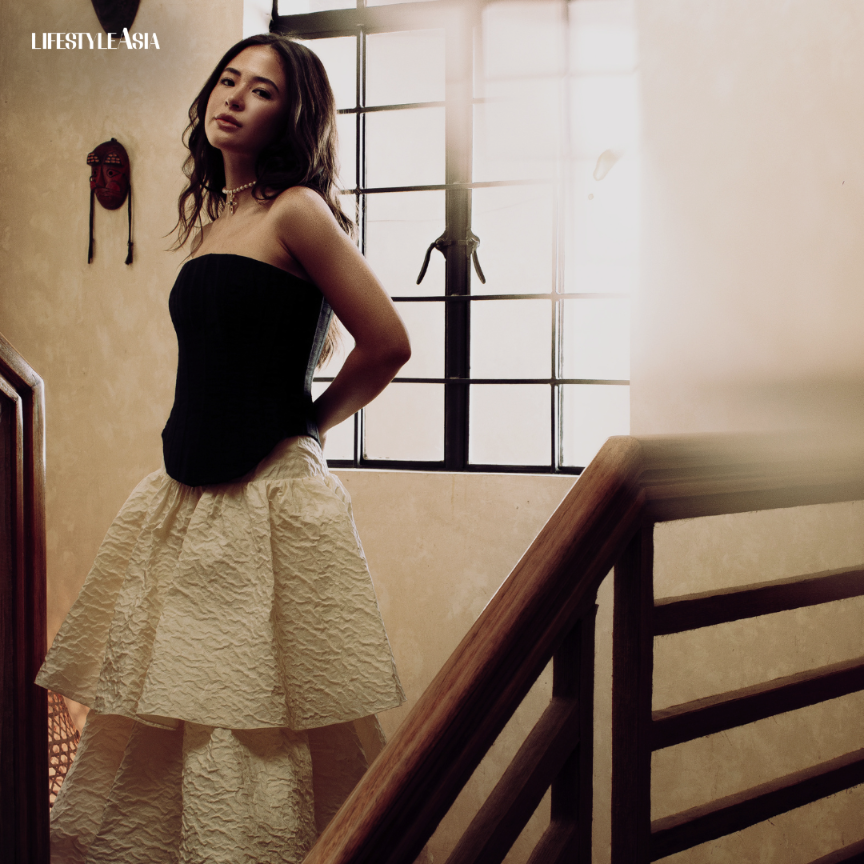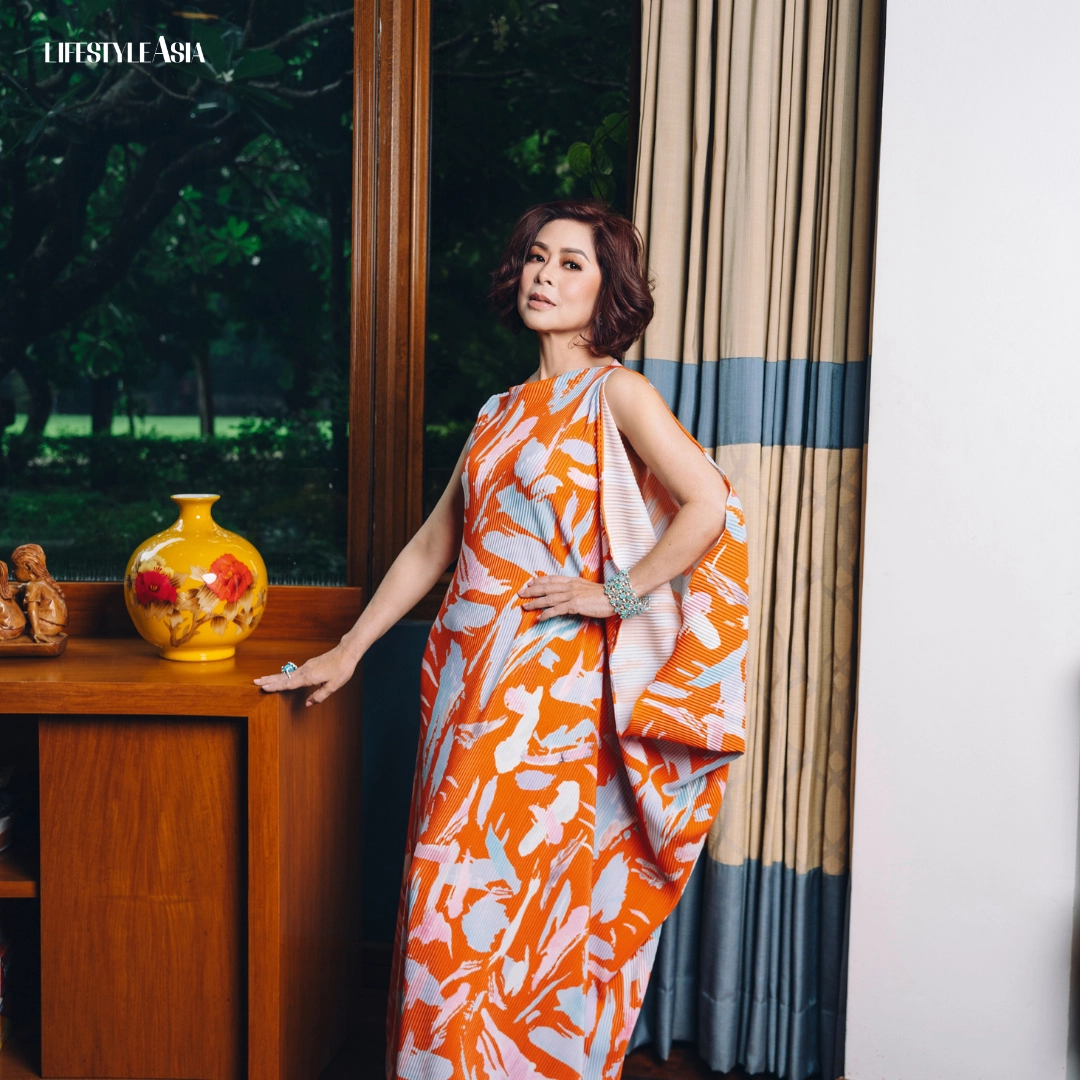As a descendant of the Lakambini ng Katipunan Gregoria de Jesús, visual artist Mercedes Olondriz reveals the vibrant layers of legacy through the repainting restoration of Bahay Nakpil-Bautista.
Walking through the old district of Quiapo in Manila, its layers unfold like a painting, each turn, each stroke, contributing to a larger picture. On a street formerly known as Calle Barbosa, the passage narrows. One of the old homes, with a unique shade of green, catches our attention.
It’s flanked by the bustling streets and the Estero de San Miguel, a tributary of the Pasig River. The Philippine flag flies proudly at its entrance, beside a red flag with the sun. Step into the zaguan, a ground-level entrance used for carriages and initial gatherings. Here, parts of the floor hold a mosaic of piedra china, once used as ballast in trade ships, now anchoring this historical space. Then it’s up the flight of stairs to the entresuelo, the mezzanine level, which holds the primary suites of its residences.
Bahay Nakpil-Bautista was once the home of Gregoria de Jesús, a woman whose name resonates through Philippine history as “the Lakambini ng Katipunan (Muse of the Katipunan),” expanding the very definition of who and how one could participate in nation-building. She was the organizer of the Katipunan’s women’s chapter and the keeper of revolutionary documents. The widow of Filipino revolutionary leader Andres Bonifacio, she later married musician and Katipunan general Julio Nakpil, becoming a matriarch whose legacy now spans five generations.
For visual artist Mercedes Olondriz, a fifth-generation descendant of De Jesús, this historical site is a living canvas. Bridging her family heritage and her craft, Mercedes manages the repainting effort of the ancestral home, part of the continuous restoration and management work that transforms historical memory into a vibrant, ongoing narrative.

READ ALSO: Fine Jewelry Designer Sofia Yulo On Why A Thing Of Beauty Is A Joy Forever
Echoes Of Gregoria de Jesús
“I grew up learning stories about her [De Jesús] from a young age,” Mercedes shares. “How she safeguarded the Katipunan’s documents and seal during the revolution, and how she once escaped on horseback— bareback!—while carrying a weapon for protection.”
The way she describes her ancestor reveals a mixture of reverence and wonder. “I’ve always thought that was so badass,” Mercedes adds. “It’s a surreal feeling to be a descendant of someone like her, who endured so much and lived through such extraordinary times.”
This year marks De Jesús’s 150th birth anniversary, a milestone commemorated through various events. From traveling exhibits to lectures and intimate family gatherings, as well as the upcoming film Lakambini: Gregoria de Jesus, each event is a thread reconnecting contemporary generations to their revolutionary roots.
“It’s been incredibly moving to see how her story still resonates with so many people today,” Mercedes reflects. “For me, personally, it’s been a reminder of the lives and sacrifices of every generation that came before mine—and it’s something that definitely shapes how I see my own place in our family’s story.”
The sense of legacy finds its tangible expression through the Bahay Nakpil-Bautista Foundation, which preserves the family’s historical narrative. Under the leadership of Maria “Bobbi” Nakpil Santos-Viola (or “Tita Bobbi” to Mercedes), the Foundation has transformed the ancestral home into a museum.
“I became involved with the Foundation about two years ago out of a desire to learn more about the family’s ancestral home,” Mercedes explains. Her contributions started with reintroducing museum merchandise, followed by organizing pop- up events and growing their social media engagement. Most recently, she got involved in a painting project that uses color to honor the home’s history.

READ ALSO: Rosanna Periquet Stepping Into Work-Life Balance
Brushstrokes Of Heritage
The painting project at Bahay Nakpil-Bautista is an extension of both Mercedes’s connection to heritage as well as her artistic practice, rooted in a family that breathes creativity.
“For as long as I can remember, I was always drawing, painting, or making something with my hands,” she recalls.
Her earliest artistic influences were deeply personal: her mother and great-grandmother. “I was in awe of how effortlessly they could draw with color,” she adds, revealing how artistic expression runs in her blood like a hereditary language.
Her formal training at the School of the Art Institute of Chicago instilled in her a sophisticated practice. Graduating with a BFA, she expanded her commissioned work to include murals and surface pattern design, carrying the understanding that art is more than visual: it’s a method of storytelling.
The restoration and repainting of Bahay Nakpil-Bautista became an extension of this storytelling. Her background in European decorative arts and art history offered a unique lens. “I tried to tap back into my university brain,” Mercedes explains, “connecting the Viennese Secession furniture that inspired the house’s design to the broader cultural context of the Philippines.”
Her technical curiosity as an artist transforms the restoration into a form of archaeological investigation. The scraped paint chips are the primary text, but each layer is waiting to be decoded. She plans to analyze pigment composition, binder materials, and environmental impact, treating the house’s surfaces like a complex, living canvas that breathes history and memory.
“I’ve come to realize that what I’ve enjoyed is the process itself,” she reflects. “Discovering what I can and can’t do, and learning to embrace both the frustrations and the quiet moments of clarity that come with creating.”
In this way, Mercedes continues a family tradition of preservation, of physical spaces that exemplify the ways stories, moments, and intricate histories live and breathe through attentive care.

A Chromatic Transformation
The repainting of Bahay Nakpil- Bautista—in collaboration with Surface Sense, using Benjamin Moore paints— resurrects a historical palette that challenges our collective imagination of the past.
“I knew from the beginning this project needed to be documented,” Mercedes explains. “It wasn’t just about applying fresh paint, but about restoring a reflection of the home’s previous lives, revealed through the layers I carefully scraped from both its exterior and interior walls.”
The chosen palette reflects the home’s appearance during the American colonial period, meticulously studied through paint layers and chips taken from various parts of the house.
“Over the course of several months, each day involved coordinating between different groups—the Bahay team, the videography crew, and the Surface Sense project manager and on-site painters,” she continues.
“To our surprise, one of the old family stories turned out to be true,” she adds. “The house had lived through many shades over time, including the green we’d always heard about! The entire experience has been incredibly rewarding and fulfilling.”
Where once stood a plain white exterior, the house now bears an eye-catching green facade, a chromatic statement against simplification. Like a painting with multiple layers, history is not a single, uniform stroke but a complex composition of intersecting narratives, vibrant and nuanced. The men and women of the revolution, the colonial period that followed, and the lives that continue to build our nation.
Whitewashing, both literal and metaphorical, flattens these rich stories, reducing the multiplicity of history to a monochromatic facade. The restoration reveals how ancestral homes are as colorful as the stories they tell, challenging the notion of historic spaces as dull or rigid. It’s simple, but by revealing the true colors of Bahay Nakpil-Bautista, we restore the depth and texture of our history.
Read the full story in our November 2025 e-magazine by subscribing to Lifestyle Asia’s digital access and purchasing your copy at Readly.
Cover photo: Dress, Marikit Capsule by MALIGAYA CLOTHING CO.; Shoes, Kimmy sandals by B BY BONNEY; Jewelry, Orphelia necklace, Perlas ring, and Luna and Araw bracelets from KATARI.
Photography by Belg Belgica Assisted by Jom Ablay
Creative Direction Paolo Torio
Stylist Gee Jocson Assisted by Teru Dequito and Reese Tio
Makeup Cats Del Rosario Hairstylist Marj Cabarrios
Associate Producer Mae Talaid
Shot on location The Bahay Nakpil-Bautista Foundation





